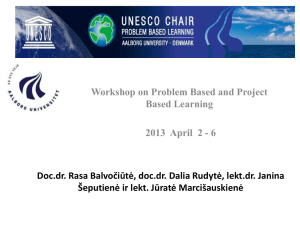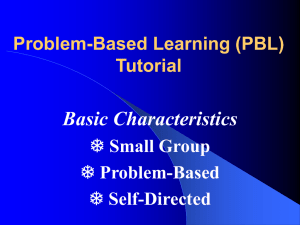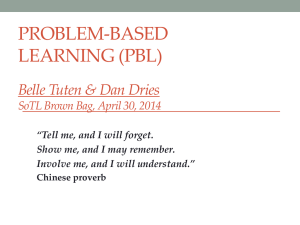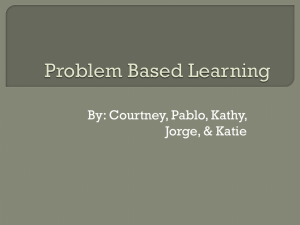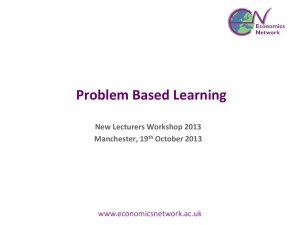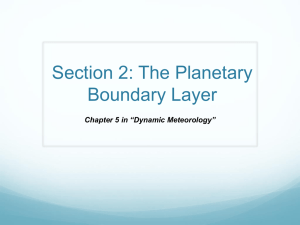File - Formative Assessment and Differentiated Instruction
advertisement
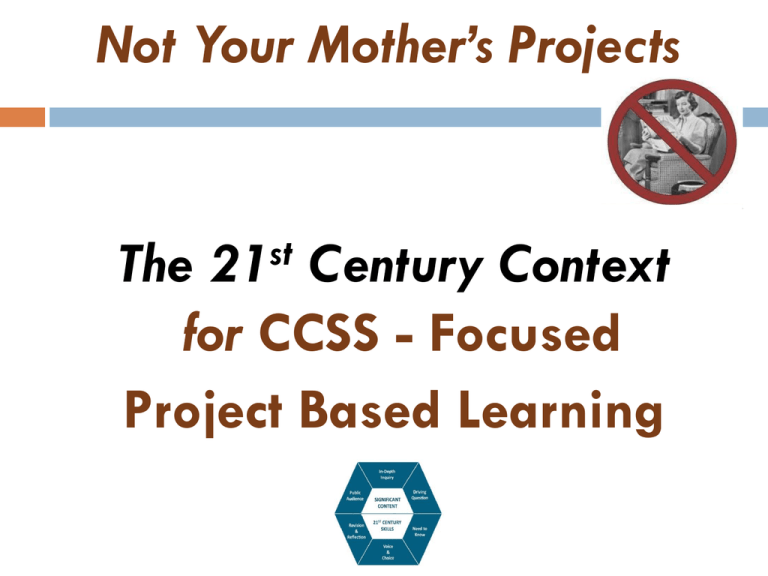
Not Your Mother’s Projects st 21 The Century Context for CCSS - Focused Project Based Learning So you don’t have to take notes, you will find this PowerPoint at… www.formativedifferentiated.com -Jacque Melin’s Website Sources used to create this PowerPoint: www.bie.org http://wvde.state.wv.us/teach21/pbl.html http://www.pblu.org/classes http://www.smarterbalanced.org/news/smarterbalanced-releases-sample-assessment-items-andperformance-tasks/ Your Driving Question… How can we, as teachers, design and implement effective PBL (units) that are aligned to the Common Core? What do you need to know… The What and the How = the WHAT = the HOW Does NOT Solve Problems of Engagement What is Project Based Learning? PBL is a systematic teaching method that engages students in learning important knowledge and 21st century skills through an extended, student-influenced inquiry process structured around complex, authentic questions and carefully designed products and learning tasks. A Project could be…. An exploration of a philosophical question – “What is a healthy community?” An investigation of a historical event or a natural phenomenon. A problem-solving situation – either real or fictitious. An in-depth examination of a controversial issue. A challenge to design an artifact, plan or event. A challenge to create a piece of writing, multimedia or work of art for a particular audience or purpose. PBL Essential Elements Publicly Presented Product Driving Question or Challenge Need to Know Feedback & Revision Inquiry & Innovation Student Voice & Choice 21st Century Skills Driving Question or Challenge Inquiry & Innovation Need to Know Student Voice & Choice Critique & Revision Public Performance & Product 21st Century Skills PBL Essential Elements Publicly Presented Product Driving Question or Challenge Need to Know Feedback & Revision Inquiry & Innovation Student Voice & Choice 21st Century Skills PBL is the MAIN COURSE NOT the DESSERT Your Mother’s Projects Dessert Project Students bring dishes from various countries for a “Food of the World” day, dressing in clothes that represent the culture. Main Course PBL Students answer the questions, “Are we the same as or different from the people in China?” as they create narrated videos, based on information from fiction and nonfiction, movies, and documentaries, and correspondence with pen pals (ePals) at a school in China. Dessert Project During a unit on plants, students grow beans, radishes, carrots, and other plants in containers in the classroom, observing their growth and recording data. Main Course PBL Students plan and install a vegetable garden, deciding what will grow well in their climate and what soil, water, and other materials they will need. Dessert Project Students cut various shapes out of different colors of paper, then label and make mobiles with them. Main Course PBL Students work with the cafeteria staff to improve the flow of students getting their lunches. They gather and record numerical data and use it to present their recommendations. Dessert Project Students write creative stories about animals and collect them into a book, which they illustrate and publish, giving a copy to each family in the class. Main Course PBL Students write on a class blog, drawing from various readings as well as interviews with each other, to express their answers to the question, “What is it like to be 9 years old?” www.bie.org Those who criticize PBL… “It’s not focused enough on content.” – They “I can’t use traditional teaching tools!” – They “I can’t cover enough material.” – They “It’s loud & messy!” – They “There’s no individual accountability.” – They “I don’t have time and support.” – They “My students aren’t ready.” – They PBL Essential Elements Publicly Presented Product Driving Question or Challenge Need to Know Feedback & Revision Inquiry & Innovation Student Voice & Choice 21st Century Skills Backward Design Process Begin with the End in Mind Decide the scope of the project 2. Select standards 3. Develop a project idea 4. Decide on culminating projects or presentations. Craft the Driving Question 1. LIMITED AMBITIOUS Duration 10-15 contact hours 40+ contact hours Breadth One subject; few standards Interdisciplinary; several standards Basic Extensive Classroom Community/World One teacher Several teachers, outside experts, community Classroom Experts, community, world, web Teacher-defined; tightly managed Co-defined and managed Technology Setting Who’s Involved Audience Student Autonomy Backward Design Process Begin with the End in Mind Decide the scope of the project 2. Select standards 3. Develop a project idea 4. Decide on culminating projects or presentations & rubrics Craft the Driving Question 1. Select Standards What do you want your students to know and be able to do? Identify the key standards that you believe might best be met through project based instruction. No more than 3 standards per subject is best in shorter projects. Adjust accordingly for interdisciplinary or longer-term projects. Include at least one literacy outcome in your project. Be clear about the standards that will be assessed and how the products will allow each student to demonstrate their learning. From the ELA CCSS…. “Conduct short as well as more sustained research projects based on focused questions …” “Prepare for and participate effectively in a range of conversations and collaborations with diverse partners …” “Use technology, including the Internet, to produce and publish writing and to interact and collaborate with others …” “Conduct short research projects to answer a question (including a self-generated question) …” Released item from Smarter Balanced… 4th Grade Performance Task http://sampleitems.smarterbalanced.org/itempreview/sbac/ELA.htm SOURCES OF INSPIRATION FOR PROJECTS o Your Content Standards o Your Students o Current Events o Real-World Practice/Problem o Your File Cabinet o Your Colleagues o Your Community o Online Project Libraries North Kent Transfer Station 80 Acre Sports Complex Vacant lot where tannery once stood North Kent Community Services Rockford Historical Museum Are there enough enrichment (other than sports) and/or volunteer opportunities available for children in Rockford? www.bie.org http://wvde.state.wv.us/teach21/pbl.html THINK SHARE YOUR IDEAS. Would PBL be an evolution of your teaching, or a revolution? Or do you do it already? Could you modify some of your current activities or “projects” so they have the 8 essential features of PBL? What are your ideas for projects? st 21 Century Skills Critical Thinking & Problem Solving Creativity & Innovation Collaboration, Teamwork & Leadership Cross-cultural Understanding Communication & Media Literacy Computing and ITC Technology Career & Learning Self-direction st 21 Century Skills explicitly taught and assessed or encouraged by project work, but not taught or assessed: ELA PBL Project Idea Healthy Choices = Long Life Students will develop a product that informs others of the dangers associated with poor nutrition and poor fitness habits as well as the lifestyle changes that can combat it. Math PBL Project Idea From Our Class to Yours New name and website: http://www.e-luminate.org/ Students will explore fractions and create books to be used by students in a school in Uganda. This is part of the Books of Hope project which specifically asks for books on non-fiction topics that can be used to teach both English and the content involved. The project links learning of content with writing skills and global studies. Science PBL Project Idea Spiders, Good Guys or Bad? Children often do not like spiders because they think they look scary. This project will help children appreciate the place spiders have in the world and will lessen their fears of spiders caused by misunderstandings. Through interactive read alouds and interactive whiteboard lessons, kindergarten students will learn that spiders are good guys because they help keep the insect population in check. Students will observe spiders in a “close to natural state” while making a classroom vivarium. Students will create a commercial using a flip camera to teach the other kindergarten students in our school that spiders can be good guys. Science PBL Project Idea Harrowing Habitats Michigan is a state rich with wildlife and beautiful scenery. Students will explore various global ecosystems to see if animals are safe and protected in their natural habitats. Then they will apply their findings to Michigan and determine any possible threats to our local wildlife. Students will then develop solutions to possible problems. Through multimedia experiences they will then relate their findings to a panel of experts. Social Studies PBL Project Idea Amazing Race: US Regions As a class, the students will create an Amazing Race challenge for another class. Students are put into production groups to create a show segment for The Amazing Race. Each group will • represent the different United States regions. • investigate the various types of geographical regions (e.g., political regions, economic regions, landform regions, vegetation regions) • create a digital poster or poster board presentation to be posted on classroom wiki for study reference • include an “ artifact ” (e.g. geographic tools/ technologies, stories, songs, and pictures) to further describe their specific region. As a class, students will present their final product and regional artifacts to another class as an Amazing Race challenge. Ultimately, the students will reflect on what they learned and write about how do other regions in the United States influence their lives? A good Driving Question meets the following criteria: 1. Engaging for Students 2. Open-ended 3. Aligned with Learning Targets From “too big” to answerable: How have humans changed the environment? How has the environment in our (state, city, etc.) changed in the past 50 years? From “Google-able” to open-ended: Which trees grow in our community? How can we create a field guide to trees in our community? From too general to more concrete and challenging: Which stories and books are the most popular for people of our age? How can we create a website that recommends books for young people in our community? From too abstract to more relevant and engaging: What is a hero? Who are the heroes in our community and how can we tell their story? From too general to more concrete and localized: What are the characteristics of healthy soil? Is our soil healthy enough to support a vegetable garden? From “sounds like a teacher” to student-friendly: How does the author use voice and perspective in The House on Mango Street to reflect on her childhood and community? How does our childhood shape who we are as teenagers? Another way to write a DQ… Ask yourself, “Who in the real world does this work?” Ask yourself, “What products are created or actions taken by people in this role?” How can we, as ______ (role), _______ (do a task/create a product) for/to/that_________ (purpose & audience)? Ask yourself, “What is the purpose of the product or action – to persuade, inform, propose a solution, be used, etc. – and who is the audience?” How can we, as newspaper reporters, write an article that explains which buildings in our community be protected as “historic?” “Yes, the Cold War!” – No One EXAMPLE ENTRY EVENTS o o o o o o o o Field Trip Guest Speaker Film, Video, Website Simulation or Activity Provocative Reading Startling Statistics Puzzling Problem Piece of Real or Mock Correspondence o Song, Poem, Art o Lively Discussion ELA PBL Driving Question and Entry Event Healthy Choices = Long Life Driving Question: Why is it important to establish habits that promote a healthy lifestyle? Math PBL Driving Question and Entry Event From Our Class to Yours Driving Question: How can we share what we know about fractions with a school in Uganda? Science PBL Driving Question and Entry Event Spiders, Good Guys or Bad? Driving Question: Should you kill a spider? Science PBL Driving Question and Entry Event Harrowing Habitats Driving Question: How can we work to protect the animals that inhabit Michigan? Social Studies PBL Driving Question and Entry Event Amazing Race: US Regions Driving Question: How do other regions in the United States influence my life? One Entry Event might not do it. http://www.awesomestories.com/ TO DOs: Select Appropriate Standards Generate a Project Idea Refine a Driving Question Determine Culminating Products Create an Entry Event* Avoid death by repetitive presentations Differentiation Presentations will differ if you have an open-ended DQ or a problem with several possible solutions Presentations will differ if students have a choice of products / ways to present answer to DQ Examples of Authentic Products Real-World Role Real-World Product Architect or Contractor Plan, drawing, model Business Person Business plan, proposal, annual report, written or oral report City Planner Plan, proposal Consultant Written or oral presentation Doctor or health care worker Written or oral presentation, informational brochure, webpage Engineer Plan, drawing, model Lawyer, judge Mock trial, brief Museum curator Exhibit Teacher Lesson Plan Written Media Presentation Training Products Construction Products Tech Products Research Report Podcast Speech Program Physical Model Computer Database Narrative Essay Graphic Novel Debate Manual Machine Website Proposal Slide Show Play Model Scientific Instrument Brief Oral History Song Proposal Museum Exhibit Poem Drawing Lyrics Estimate Diorama Poster Blog Musical Piece Bid Movie Script Oral Report Blueprint Outline Dramatic Reenactment Flow Chart Brochure Panel Discussion Time-line Survey Newscast Questionnaire Skit Autobiography Discussion Essay Dance Book Review Proposal Report Data Display Editorial Product Exhibition App “I CAN use traditional teaching tools!” – You Key Points to Remember about Rubrics in PBL Each major product or presentation will need its own rubric. Rubrics are not the same as checklists Checklists = assess completion Rubrics = assess quality KITTY KARRIER PROJECT REQUIREMENTS ☐ Low Cost Materials ☐ No Metal Parts ☐ Fit Underneath Seat on Plane ☐ Open & Close Access ☐ Comfortable & Breathable ☐ Rigid Structure KITTY KARRIER PROJECT REQUIREMENTS ☐ Low Cost Materials ☐ No Metal Parts ☐ Fit Underneath Seat on Plane ☐ Open & Close Access ☐ Comfortable & Breathable ☐ Rigid Structure Key Points to Remember about Rubrics in PBL Each major product or performance will need its own rubric. Rubrics are not the same as checklists Checklists = assess completion Rubrics = assess quality Assess content knowledge/skills separately from 21st century skills Key Points to Remember about Rubrics in PBL Each major product or performance will need its own rubric. Rubrics are not the same as checklists Checklists = assessing completion Rubrics = assessing quality Assess content knowledge/skills separately from 21st century skills Use student friendly language and show rubrics to students early to help guide their work Use rubrics as formative assessment tools. SELF PEER Rules for the CULTURE OF CRITIQUE Be kind. Be specific. Be helpful. Continuum of Assessment Daily Homework Weekly Quiz Lab Informal assessment Mid-project milestone Essay Mini-Presentation Model Storyboard Blueprint Early milestone Journal Self-reflection Preliminary plans Group process report End of project Exhibition Completed artifact Oral presentation Defense before a panel Unit Test Public Audience – Why? Present work to other people, beyond their classmates and teacher in person or online “Ups the stakes” Increases students’ motivation to do high-quality work Adds to the authenticity of the project. TO DOs & Final Tips: Write Project Overview for Students List Criteria for Major Products and Write Rubrics Plan Day-to-Day Activities and/or Develop Project Calendar Gather Content Resources What to record on the Project Calendar • • • • • • • • Entry Event Daily teaching and learning tasks Checkpoints Practice Presentations Presentation Schedule Dates for Project Completion Tests or other summative assessments (if applicable) Time for reflection and celebration http://mpcavazos.glogster.com/ TEAMING TIPS o Teacher decides teams (or manages the process) o Four is best o Usually heterogeneous o “Slacker hardball” Re-teach teamwork every time they do it. For Planning…. Use the FreeBIE Material from the Buck Institute www.bie.org THINK SHARE WHAT ARE YOUR SHORT TERM AND LONG TERM GOALS. How will what you learned today about PBL change your curriculum, instruction and/or assessment practices as you plan for implementing the CCSS? Please contact me if I can help: Cell: 616-450-0998 or Email: melinj@gvsu.edu

